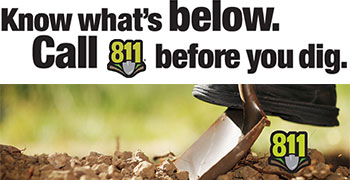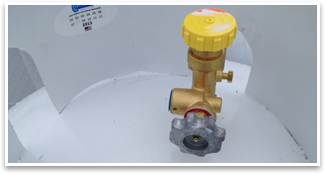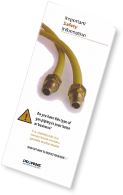Safety Tips
Using space
heaters safely
Appliance
maintenance
Appliance
connectors
If you move or
get a new
appliance
- USE THE RIGHT KIND OF HEATER. Some propane space heaters are designed only for use outdoors. Others are designed only for use indoors. Check your owner's manual or contact a qualified service technician to be sure you are using the right kind of heater.
- DO NOT USE AN OUTDOOR HEATER INDOORS. High levels of CO can be generated from heaters that are not designed for indoor use. High levels of CO can make you dizzy, give you headaches, or cause flu-like symptoms. In extreme cases, extended exposure to CO can result in brain damage or death.
- READ YOUR SPACE HEATER MANUAL.The appliance manufacturer's manual that came with your space heater tells how to set up and operate it safely. Read the entire manual and carefully follow all directions.
- MAINTENANCE IS IMPORTANT. All appliances using propane must be properly maintained in order to operate safely, properly, and efficiently.
- LEAVE IT TO THE EXPERTS. Only a qualified service technician has the proper training to install, service, maintain, and repair your appliances. Make sure you have a qualified service technician install and service your appliances.
- ANNUAL INSPECTION IS IMPORTANT. Contact a qualified service technician to perform an appliance inspection.
- BE SURE YOUR APPLIANCES CAN "BREATHE" PROPERLY. Regularly check the vents of your appliances to be sure that flue gases can flow easily to the outdoors. Insects, birds, and small animals sometimes build nests in vent pipes. Other obstructions such as snow or ice may also occur. If you see evidence of this, call a qualified service technician. Also, clear the area around your appliance to be sure plenty of air can reach the burner for proper combustion. Note: Not all propane appliances require venting.
- NEVER store combustible materials near appliances.
- WATCH FOR YELLOW FLAMES OR SOOT BUILD-UP. When appliances are operating properly, propane burns with a blue flame. If you see yellow flames, or notice significant amounts of soot on any equipment, the gas may not be burning completely. This can create carbon monoxide, a colorless, odorless, and poisonous gas. Contact a qualified service technician if any of the above conditions occur.
- PROPERLY INSTALL AND MAINTAIN CONNECTORS. The final section of the system that brings gas to your appliances is the appliance connector. It is important that all appliance connectors are properly inspected, installed, and maintained by a qualified service technician.
- HAVE CONNECTORS CHECKED WHEN MOVING OR REPLACING APPLIANCES. Connectors can wear out from too much moving, bending, or corrosion. Connectors should be checked by a qualified service technician whenever the appliance is replaced or moved from its location.
- USE ONLY APPROVED APPLIANCE CONNECTORS. Make sure that all connectors and gas piping/tubing that bring propane to your appliances are installed by a qualified service technician and approved by a nationally recognized testing laboratory.
- APPLIANCE CONNECTORS MAY NOT be run through walls, partitions, cabinets, etc.
- HAVE OLDER APPLIANCE CONNECTORS INSPECTED. Over time, some types of appliance connectors can crack or break, resulting in a serious gas leak and the possibility of fire or explosion. The Consumer Product Safety Commission (CPSC) has warned that certain types of older connectors are extremely dangerous. If you have an appliance that is more than 20 years old, have a qualified service technician inspect the connectors to be sure they are safe and meet current safety-code requirements.
- USE CAUTION WHEN MOVING AN APPLIANCE YOURSELF to check the connector; this might damage the connector and create a leak.
- TREAT CONNECTORS WITH CARE. When an appliance is moved, be careful not to damage the appliance connector (the flexible tubing that brings gas to the unit). Older connectors can crack if flexed or twisted, which can lead to a gas leak.
- IS THE APPLIANCE DESIGNED TO USE PROPANE? Be sure that any new or used appliance being installed is designed for use with propane. Natural gas appliances SHOULD NOT be used with propane unless a qualified service technician has made required adjustments to the appliance.
- HAVE THE APPLIANCE CHECKED OUT BEFORE YOU USE IT. Be sure that the appliance is properly installed and that all controls and valves operate correctly. Contact a qualified service technician for assistance.
- CAP OR PLUG UNATTACHED GAS LINES. If you move a gas appliance and disconnect it from a gas line, be sure to contact your propane retailer or a qualified service technician to close, cap, or plug the open gas line. Any connectors or gas line not connected to an appliance can leak gas, or can be damaged if water accumulates inside it. The valve on any unattached gas line must be closed, and the open end must be sealed by installing a threaded cap or plug.
Tampering with
appliances or
propane
Propane vapors can be dangerous
Corrugated Stainless Steel Tubing (CSST)
Call 811 Before You Dig
- DO NOT UNDER ANY CIRCUMSTANCES try to modify or repair valves, regulators, connectors, controls, or other appliance and cylinder/tank parts. Doing so creates the risk of a gas leak.
- CALL AN EXPERT. If you are unable to operate any part of your propane system, or if you think an appliance or other device is not operating properly, call your propane retailer or a qualified service technician. They can inspect, adjust, repair, or replace any part of your propane system.
- YOUR PROPANE SYSTEM IS DESIGNED FOR SAFETY. Propane cylinders, tanks, and appliances incorporate special components (such as valves, connectors, controls, burners, and pilot lights) to keep them safe for use. Damaging these components can cause gas leaks.
FLAMMABLE VAPORS ARE A SERIOUS SAFETY HAZARD!
- Vapors from flammable products such as gasoline, kerosene, paint thinner, and solvents, can be ignited accidentally by the pilot light of a propane appliance.
- Flammable vapors are often heavier than air and may travel along the ground and collect in low or confined areas (such as a basement or pit). Sometimes the vapors may follow air currents in the building to higher levels. Any source of ignition in these areas (such as a pilot light, spark, heater element, or electric motor) could cause an explosion or a fire.
TO HELP REDUCE THE RISK OF FLAMMABLE VAPOR IGNITION:
- Store flammable liquids in well-sealed containers outside.
- Do not use gasoline, cleaning fluids, oil-soaked rags, or other flammable liquids inside a building where propane appliances are located.
PROPANE VAPORS CAN BE DANGEROUS.
Propane vapor is also combustible and can ignite explosively. Keep propane storage containers closed. Never store propane cylinders in an enclosed area, or near a heat or ignition source.
Lightning Safety Warning from Manufacturers of Corrugated Stainless Steel Tubing (CSST)
Corrugated Stainless Steel Tubing (“CSST”) is flexible, stainless steel piping that is used in residential, commercial and industrial settings for the transmission of liquefied petroleum gas (“LPG”), more commonly known as propane. CSST is distinguishable by its yellow (or black) exterior plastic coating. As installed inside a home or business, CSST is typically located within the walls of a structure, through or alongside floor joists in a basement, or on top of ceiling joists in an attic.
Lightning strikes at or near properties equipped with CSST have occasionally been reported to result in fires at those properties. It is believed that nearby lightning strikes can cause electrically conductive components, like CSST, to become energized, which can result in pitting or other damage to the CSST and, in turn, could cause an explosion and/or fire. If you determine that you have CSST at your home or business, CSST manufacturers strongly encourage you to make sure your CSST system is properly bonded and grounded in order to reduce the risk of damage from a lightning strike. The manufacturers recommend contacting a licensed electrician to perform such bonding and grounding work.
States with significant lightning risk include, but are not limited to: Alabama, Arkansas, Florida, Georgia, Illinois, Indiana, Iowa, Kentucky, Louisiana, Maryland, Michigan, Mississippi, Missouri, New Mexico, North Carolina, Ohio, Oklahoma, Pennsylvania, South Carolina, Tennessee, Texas, Virginia and West Virginia, as based on data collected by the National Lightning Detection Network and compiled in the Cloud-to-Ground Flashes by State 1997 to 2012: www.lightningsafety.noaa.gov/stats/97-12Flash_DensitybyState.pdf
For more information on CSST safety, please visit www.csstsafety.com
For more information about the various CSST products manufactured by CSST manufacturers, please visit their individual websites, a non-exclusive list of which is below. These website links are provided for convenience; AmeriGas assumes no responsibility or liability for the content contained on any of the following websites:
- Metal-Fab, Inc. (manufacturer of Diamondback) - www.mtlfab.com
- Omegaflex, Inc. (manufacturer of TracPipe and CounterStrike) - www.tracpipe.com
- Parker Hannifin, Corp. (manufacturer of
Parflex) – www.parker.com - Pro-Flex, LLC (manufacturer of ProFlex CSST Flexible Gas Piping) - www.proflexcsst.com
- Titeflex Corporation (manufacturer of the Gastite System Corrugated Stainless Steel Tubing) - www.gastite.com/index.html
- Ward Manufacturing, Inc. (manufacturer of Wardflex and Wardflex II) - www.wardflex.com/index.htm

A federally-mandated national number "Call Before You Dig" (811), was created to help protect you from unintentionally hitting underground utility lines while working on digging projects. People often make risky assumptions about whether or not they should get their utility lines marked before digging due to concerns about project delays, costs and previous calls about other projects. If you hit an underground utility line while digging, you can harm yourself or those around you, disrupt service to an entire neighborhood and potentially be responsible for fines and repair costs. These assumptions can be life-threatening.
Are you planning on building a deck? Planting a tree? Installing a mailbox? If so, call 811 before you dig and you will be connected to your local call center. Whether you are a homeowner or a professional excavator, your underground utility lines will be marked for FREE when you call 811!
Be sure to check with your State rules and regulations governing digging prior to any excavation.


